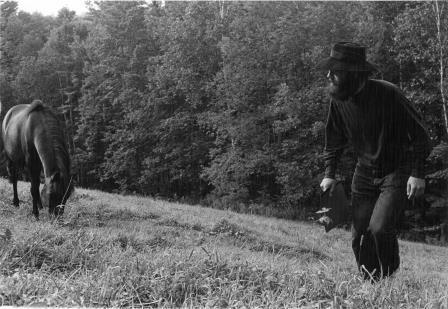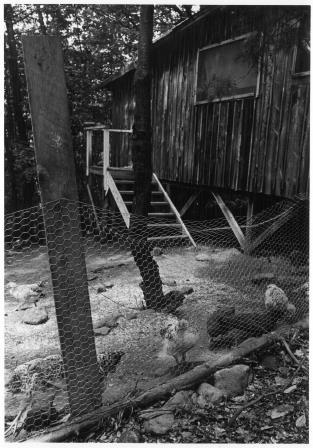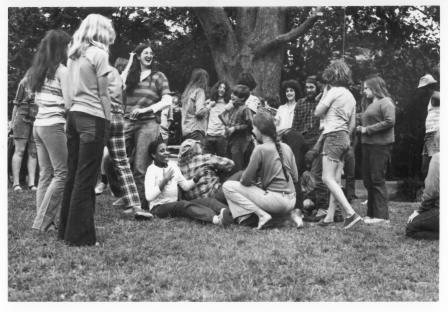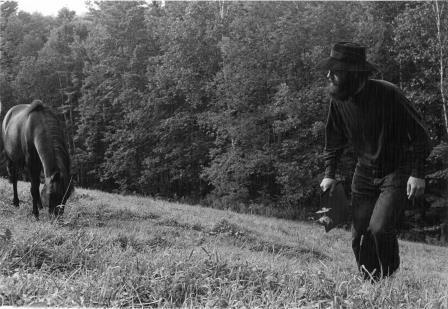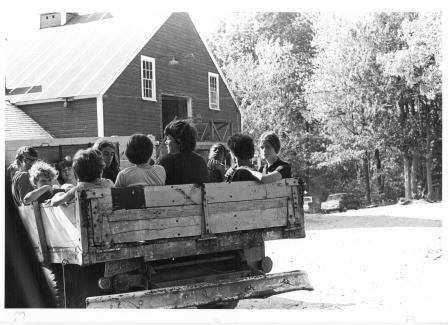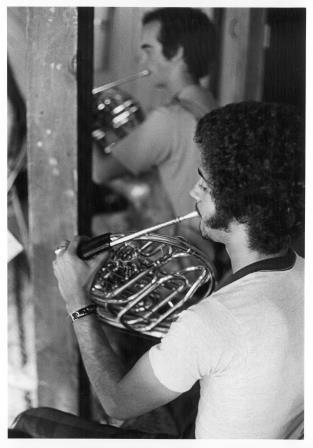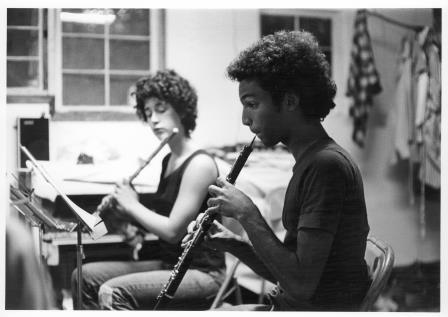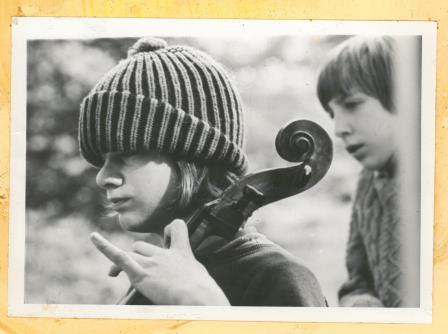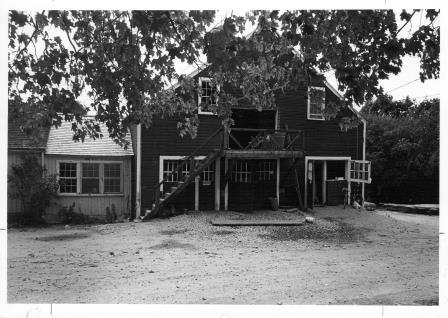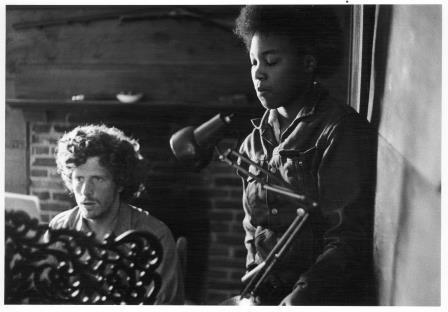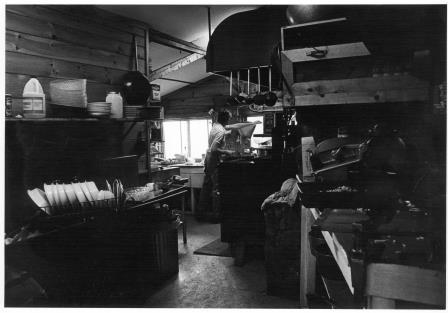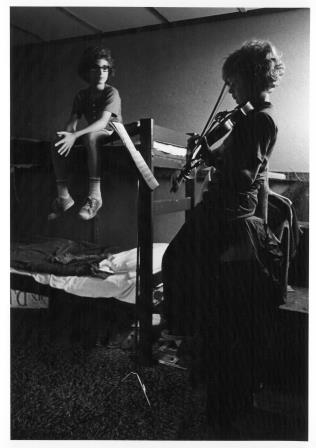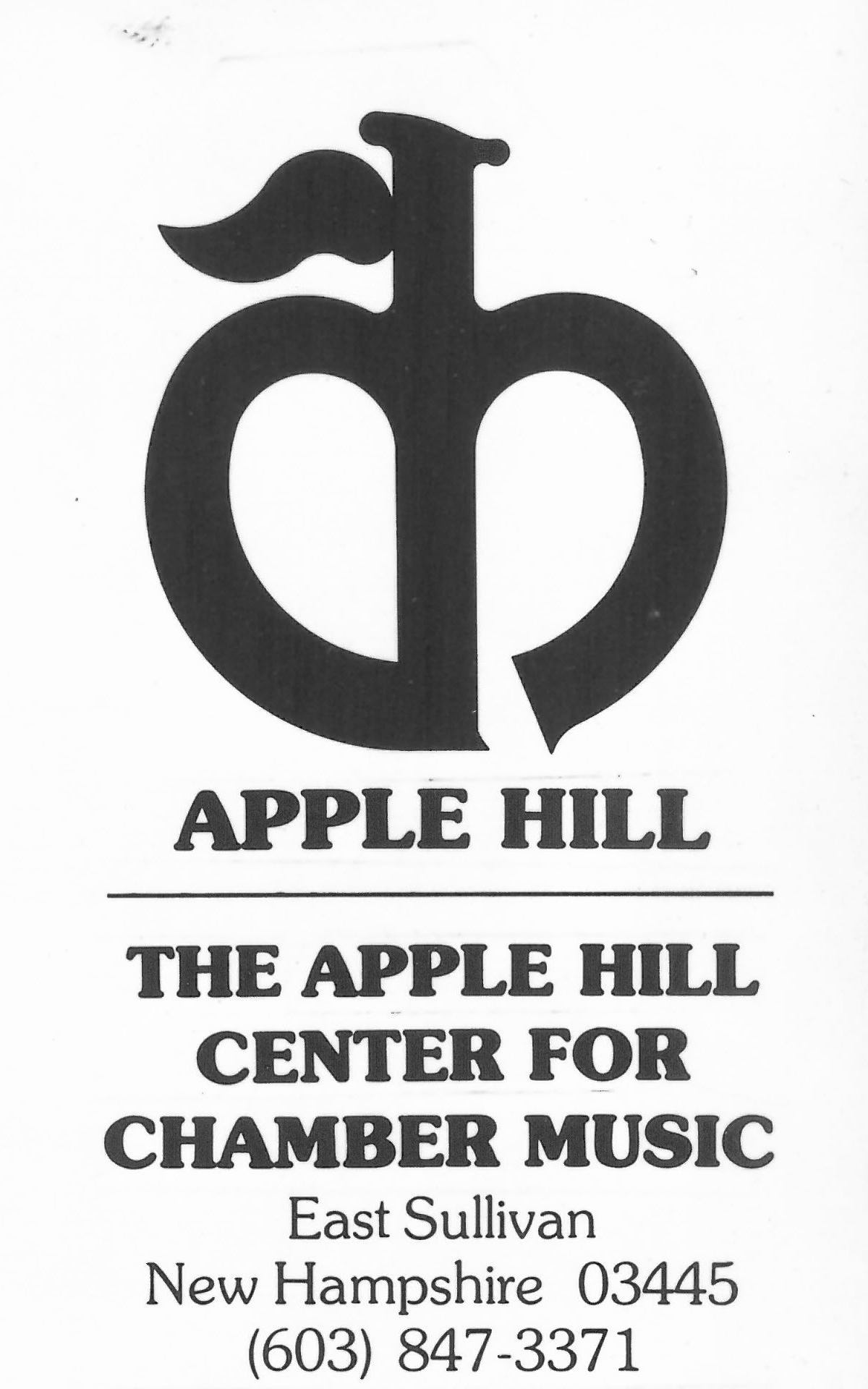

The original Apple Hill Chamber Players, c. 1973 : Back row left to right: Beth Pearson, cello; Robbie Merfeld, piano; John Laughton, clarinet; Betty Hauck, viola; Eric Stumacher, piano; Richard Hartshorne, string bass
Seated left to right: Freddie Ortiz, violin; Julie Feves, bassoon; Fred Cohen, oboe; Jimena Lasansky, dancer; David Jolley, horn
Seated front: Bonnie Insull, flute
Apple Hill began as the brainchild of Gene Rosov, a young cellist and Harvard undergrad who taught cello at the All-Newton Music School in a suburb of Boston. Inspired by his experience as a teenager at Greenwood Music Camp in Cummington, Massachusetts, Gene’s dream was to start a chamber music camp for his own students and their friends and siblings. His first camp session took place on a borrowed property in Hinsdale, New Hampshire in 1968. The original plan was for the camp to be part of a ski development that was being built in Kingfield, Maine by a friend of Gene’s, John Marden, and the next two summers “Bigelow Mountain Music Camp” as it was then called took place on rented properties in Kingfield. But then because of a recession the idea of a ski development was abandoned. With the generous support of Lee Gillespie, Best Foods heiress, Gene secured the Apple Hill property in Nelson, New Hampshire in 1971. Gene’s camp finally had a permanent home and The Center for Chamber Music at Apple Hill was incorporated as a non-profit the same year. The property consisted of 100 acres of field and forest on a sloping hill with a western view of the mountains of Vermont and an original 1790 farmhouse, two barns, a sugar house, and numerous outbuildings and cabins in various states of dilapidation.

Apple Hill in the 1930s–Sugar House (left) and Concert Barn (right)
Students came mostly from the Boston area and ranged in age from 9 to 18 years old. Faculty were friends of Gene, notably the pianist Robbie Merfeld whom Gene had first met at Greenwood, and friends of friends with connections through Kinhaven Music Camp as well as Greenwood, Aspen Music Festival, Oberlin College, Juilliard School of Music, and Brandeis University. While the original focus of Apple Hill was the summer educational program, the faculty were all young performing artists who enjoyed reading and playing chamber music together, presenting informal concerts for the students and in nearby venues. Dan Savage, the husband of faculty cellist Beth Pearson, was an amateur horn player and tenor who was attending Harvard Business School during the school year and teaching at Apple Hill in the summer. It was through his enthusiastic entrepreneurship that The Apple Hill Chamber Players (precursor of the current Apple Hill String Quartet) was born in 1973. The first concert took place at the Horace Mann School in New York City and was followed by successful concert series in New Hampshire, Boston, Philadelphia, and Lincoln Center in New York City.
All arts organizations rely on donors and Apple Hill was fortunate to receive generous local support in the early days, notably from Louise Shonk Kelly, an amateur pianist and philanthropist who lived in nearby Dublin, New Hampshire. It is in her honor that the concert barn was named.

Apple Hill garden in the ’70s
The summer educational programs continued to expand and evolve over the years from an all-summer camp for teenagers to five 10-day sessions for all ages. The Players were what is known as a “flexible ensemble” and included a string quartet, two pianists, string bass, and wind quintet. Over the years the Players consolidated into a piano and string group with occasional guest wind players. In the fall of 1973, several of the Players decided to move from the city and make Apple Hill their year-round home. As the Chamber Players became better known, they began to tour regionally, then nationally, and eventually, in 1989, internationally, through the Playing for Peace program.
Gene eventually left Apple Hill to pursue other business ventures and after successfully launching the Chamber Players, Dan Savage also moved on to other pursuits. The directorship of Apple Hill was passed on to Pat Minot for a few years, then to Carla Press for a brief period, and Eric Stumacher, one of the two pianists, eventually became Executive Director. The Chamber Players made all artistic decisions, such as repertoire and choice of guest artists, collectively, through consensus. Over the years various players/faculty came and went but a core group of players made up of Robbie Merfeld and Eric Stumacher, both pianists, Betty Hauck, viola, and Richard (“Dobbs”) Hartshorne, string bass, who joined Apple Hill in 1974, were a steady presence until the mid-1990s. The violinist Mowry Pearson, cousin of Beth, also spent many years as part of the Apple Hill Chamber Players. Other violinists included Valerie Vilker Kuchment, who was from Russia and is presently a member of the Boston Symphony Orchestra, and Anthony Princiotti, who went on to conduct the Dartmouth Symphony Orchestra for many years.
Over time a philosophy of teaching and community-building evolved at Apple Hill that was based on mutual respect, acceptance, listening to each other, and supporting and cultivating each student’s unique abilities, no matter what their skill level or experience.
The buildings and grounds at Apple Hill also evolved as time went on. Cabins were replaced, outbuildings were torn down, and major renovations took place, including the concert barn restoration by local architect Rick Monahan. With the help of a generous grant from the Kresge Foundation the Rehearsal Barn was renovated with expanded practice facilities.
In 1989, the Playing for Peace program was launched with the help of Eric Stumacher; Phillip Levy, a Welsh/Israeli violinist and member of the Players; Harriet Feinberg, Apple Hill recruiter and peace activist; Arthur Cohen, a local Keene doctor and supporter of Apple Hill; and generous donors and federal cultural agencies. The Players traveled to Israel to give chamber music workshops for students, play concerts, and award scholarships to both Jewish and Palestinian Israeli students to come study at Apple Hill in the summer. With the help of Martin Quinn, who worked for the U.S. State Department, this program expanded over the years to include other Middle Eastern countries (Syria, Egypt, and Jordan) as well as Turkey, Morocco, Poland, Ireland, and Cyprus. In 1992, a PBS special was made about one of the trips that the Players took to the Middle East for the Playing for Peace Program.

Apple Hill garden, Sept. 2016
In 2008, longtime Apple Hill faculty and violist Lenny Matczynski took over the leadership of Apple Hill as the Artistic and Executive Director. That year, the Apple Hill Chamber Players became the Apple Hill String Quartet, when longtime Chamber Players Elise Kuder, violin; Mike Kelley, viola; and Rupert Thompson, cello, were joined by Sarah Kim, violin, to create a string quartet in residence. Violinist Colleen Jennings joined the group in 2013, replacing Sarah Kim, and violinist Jesse MacDonald joined the group in 2020, replacing Colleen. Jacob MacKay, cello, joined in 2024, replacing Rupert. In 2022, Lenny Matczynski stepped down and Javier Caballero served as Executive Director, followed by Sam Bergman beginning in 2024.
The Playing for Peace program continues to expand and has been absorbed as an institutional philosophy of inclusion, bringing together students and faculty from around the world including those who are underrepresented in classical music, separated by racial or ethnic discord, or by differences of gender, ideology, religion, age, or playing level.

Sugar House Ribbon Cutting, Summer 2016. Richard Anderson with summer participants
With the support of a new generation of donors, Apple Hill set to work revitalizing the facilities, now over 40 years old. New buildings included the year-round Hoffman Auditorium, built with the help of the Community Development Block Grant (CDBG) and Community Development Finance Authority (CDFA) programs; the Bath and Shower Barn, built with the help of the USDA Rural Development Program; and more than half of the 24 cabins scattered across the campus. The 1790 farmhouse received a fresh coat of paint and the interior was redesigned to reflect the growing staff. The iconic sugar house received a major renovation in 2016 and since 2008 the grounds have been improved with flower, herb, and vegetable gardens – landscaping worthy of the beautiful rural setting.

Summer participants from Community MusicWorks in Providence, RI
The summer workshops continue to be a vital centerpiece of Apple Hill. All five summer sessions are fully enrolled with participants from the international and domestic Playing for Peace program alongside musicians of all levels and ages from around the globe – 300 students in all, coached by 45 faculty.
The ideals of the Apple Hill Community that originated years ago still exist today: a community built on mutual respect, acceptance, listening to each other, and supporting and cultivating each other’s unique abilities, no matter what skill level or experience. The ideals of the Apple Hill community are similar to those of chamber music – a collective voice of mutual cooperation where the whole is greater than the sum of the parts.
Land Acknowledgement
Apple Hill is located on N’dakinna, the traditional homeland of the Abenaki, Pennacook, and Wabanaki Peoples. We acknowledge and honor with gratitude the Native history and culture of the Monadnock Region, past, present, and future.
The Tree
Betty Hauck, founding member of Apple Hill and violist-in-residence, 1973-1995, tells the story of the iconic elm tree at the center of Apple Hill. Click here to read the full story and get a glimpse of Apple Hill’s campus and spirit through the years.
It was love at first sight, but it’s not what you’re thinking. I fell in love with a place, not a person. It was the summer of 1971 and I was heading up to spend a month teaching and performing at a summer music camp for the first time. Not knowing what to expect I drove up the dirt road in Nelson, NH towards this place that was called Apple Hill – the road was a narrow one, winding and hilly, with beautiful old maple trees on either side. It had taken me about two hours to get here from my apartment in Cambridge and this dirt road was the last two miles of the trip. I was twenty-five years old and I was both excited and nervous. I finally rounded the last bend in the road and was greeted by a sight that took my breath away – it was the most beautiful place I had ever seen! It’s true, I fell in love. How can I describe that first sight of Apple Hill with the majestic elm tree towering over all, the view over-looking the hills of Vermont, the antique yellow cape and the red barns and sugar house? It was magical! At that moment I had the strange sensation of a voice whispering in my ear that I would be here as long as the tree was. This made no sense at the time since I had come up to teach for only a month, but somehow I had a feeling that my life had changed forever – and it had!
Dvorak and the Blizzard of ’78
Betty recounts a memorable winter concert and a special recording. Click here to read the full story.
